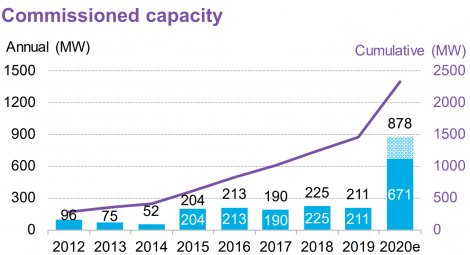Renewable Energy Survives Tumultuous Year
 | Holly Fritz, Communications/Policy Associate |

 | Holly Fritz, Communications/Policy Associate |
Every year, The Business Council for Sustainable Energy and Bloomberg New Energy Finance team up to highlight the state of renewable energy in the last year. While 2020 wasn’t what anyone expected, it was still a monumental year for the U.S. energy sector.
According to the report, demand for all forms of energy fell in 2020, except renewable energy. Thankfully, the pandemic had little to no impact on construction activity, allowing 2020 to see the highest number of renewable energy installations ever. Over 33.8 GW of new capacity hit the grid, a 61 percent increase from 2019. With these amazing additions, an impressive 40 percent of U.S. power generation was carbon-free, and renewables provided one-fifth of the country’s energy needs.
New clean energy investment was down 11 percent from 2019, yet still accounted for nearly 20 percent of the global total at $85 billion. In fact, global energy investment reached $500 billion for the first time – a nine percent increase from 2019. Wind and solar accounted for 90 percent of all renewable energy investments in 2020.
The U.S. is moving toward a cleaner and brighter energy future as more utilities announce retirements of their coal fleet. About 8 GW of coal came offline in 2020, including the 1,100 MW Coal Creek Station plant in North Dakota and The Columbia Energy Center in Wisconsin.
With wind prices down 70 percent in the last decade and low installation and operation costs, the U.S. continues to expand its wind portfolio. In 2020, 17.1 GW of new wind power was added, representing a $17.7 billion investment, which increased capacity by 85 percent. Half of these new projects were developed in five states: Texas, Iowa, Oklahoma, Wyoming and Illinois. The total amount of wind energy in the U.S. now stands at an impressive 122 GW.

Solar is also reaching its potential as a low-cost, reliable energy resource. Prices have fallen 90 percent in the last 10 years. Cheap technology costs have helped drive an additional 16.5 GW. U.S. solar investment is at an all-time high, reaching $23.1 billion in 2020. Now, there’s nearly 89 GW of solar energy nationwide!

Energy storage had a monumental year. In February 2018, the Federal Energy Regulatory Commission (FERC) issued Order 841 to create more opportunities for storage to participate in the energy market, and encourage additional storage deployments. Thanks to a decrease in lithium-ion battery pack prices, 2020 was the largest year of energy storage installations across the United States to date. About 878 MW of energy storage projects were commissioned in 2020. Two large projects in California made up 550 MW of this total.
On the policy front, the year ended on a high note with the passage of the Energy Act of 2020, a $900 billion COVID-19 recovery package that could stimulate $34 billion in new spending on decarbonization over the next decade. This legislation also extends key tax credits for renewables, energy efficiency and other clean energy technologies, and authorizes $19 billion for energy research and development over the next 10 years, including $1 billion for energy storage alone.
The report also stressed that investing in transmission is key to renewable development, meeting renewable energy goals and enhancing grid resilience and reliability in case of extreme weather events. New transmission can maximize the value of low-cost, emissions-free wind energy. Additionally, transmission projects deliver significant economic benefits, including jobs, rate savings for customers and millions of dollars in new state and local tax revenue. In response, utilities are ensuring they provide reliable, affordable, clean and safe power for their customers. Investor-owned utilities and independent transmission developers spent a record $23.4 billion on electric transmission in 2019, and transmission investment jumped 12 percent in 2020 to $26.1 billion. American Clean Power Association (ACP) estimates that all new U.S. transmission lines commissioned by 2024 could enable tens of thousands of megawatts of new wind capacity. From 2017-2020, the Midcontinent Independent System Operator (MISO) led the way on new transmission lines across the Midwest, providing access for new wind resources in Iowa, Minnesota, Missouri, Illinois, Wisconsin, North Dakota and South Dakota.
After a challenging year, renewable energy persevered, and powered American homes at the least cost while reducing carbon. U.S. carbon emissions fell 9.2 percent in 2020, and as more companies make carbon reduction pledges, the brighter the future looks.
Renewables first – it’s the smart choice!